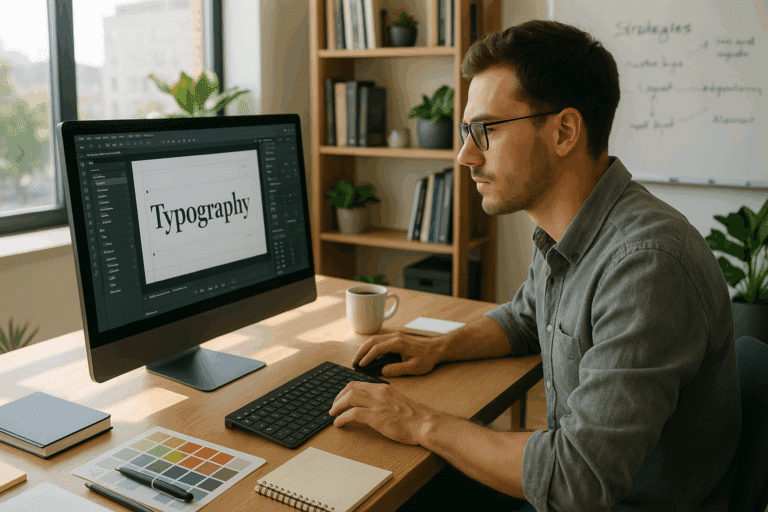Anúncios
As screens become the primary medium for reading, the importance of typography to augment readability and enhance user experience is greater than ever. This article aims to provide you with a comprehensive guide on leveraging typography techniques to improve readability on screens. Whether you are a seasoned designer or a newcomer in the digital design space, this article will equip you with the knowledge and understanding to make your designs more readable and user-friendly.
Typography, at its core, is an art that can transform the way information is perceived. It can set the tone, create an atmosphere, evoke emotions, and significantly impact the readability of content. Understanding and utilizing the right typography practices can result in designs that are not only aesthetically pleasing but also effortless to comprehend, reducing cognitive load on users. This article will delve deep into the science and art of typography, providing insights into how you can use it to your advantage.
We will begin our journey by understanding what typography is and why it plays a pivotal role in improving readability on screens. This understanding will set the foundation for the following sections, where we will discuss the principles of typography, including typefaces, font sizes, line length, line spacing, and more. These principles, when used effectively, can significantly enhance the readability of your designs.
As we move forward, we will explore how different screens and devices impact typography decisions. The rise of mobile usage has necessitated the need for responsive typography, which ensures that your text is readable and aesthetically pleasing across different devices and screen sizes. We will delve into strategies for achieving this, along with examples of effective and ineffective typography practices.
Furthermore, we will delve into the nitty-gritty of typography. We will discuss kerning, tracking, and leading, techniques used by professionals to refine the appearance and readability of text. By understanding these techniques, you will be able to elevate your designs to a professional level, making your text not only readable but also visually captivating.
Last but not least, we will shed light on the relationship between typography and user experience (UX). The intersection of these two elements can make or break your design. By understanding how typography impacts UX, you will be able to create designs that are not just visually attractive but also functional and user-friendly.
At the end of this article, you will have a solid understanding of how to use typography to enhance readability on screens, creating designs that are not only aesthetically pleasing but also user-friendly. Regardless of your level of experience, this article will provide you with a toolbox of strategies, tips, and techniques that will empower you to make informed typography decisions, leading to better, more effective designs.
The journey to mastering the art and science of typography may seem daunting, but with the right knowledge and understanding, it can be an enlightening and rewarding experience. So, let’s dive in and explore the fascinating world of typography!
Mastering the Art of Screen Typography: An Introduction
When it comes to designing for screens, typography plays a pivotal role in enhancing readability and ensuring a seamless user experience. However, mastering the art of typography for screens is a task that requires technical know-how, creativity, and a keen understanding of the reader’s perspective. As Rodrigo Almeida, a seasoned technical writer with a background in Software Engineering, I will guide you through the labyrinth of screen typography. Armed with over a decade of experience, I’ve crafted this article to help you understand the intricacies of typography and apply them to improve readability on screens.
Typography is much more than choosing a suitable font and setting the right size. It’s about understanding the medium, the content, and the audience. It’s about creating a balance between aesthetics and functionality. In a screen environment, this can be a delicate act to perform, given the range of devices, resolutions, and user settings.
To help you navigate this complex landscape, we will delve into key aspects such as the selection of typefaces, understanding font size and line spacing, the application of color and contrast, and more. These elements, when utilized effectively, can significantly enhance readability and user engagement. So let’s dive in!
Choosing the Right Typeface: Form and Function
One of the fundamental elements of screen typography is the typeface. A well-chosen typeface not only sets the tone for your content but also contributes significantly to readability. There’s a vast sea of typefaces available, each with its own character and functionality. The task of selecting the right one can be overwhelming, but understanding their classifications and purposes can simplify the process.
Typefaces can be broadly classified into Serif, Sans Serif, Script, and Display. Serif fonts, characterized by small lines or strokes attached to larger strokes, are often used for long-form content due to their readability. Sans Serif fonts, on the other hand, lack these small strokes and offer a clean, modern look, making them a popular choice for screen design.
Script fonts emulate handwriting and are typically used for decorative purposes, while Display fonts are designed for large sizes and are often used for headings. Understanding the characteristics and use cases of these typefaces can guide you in making the right choice for your design. To help you further, let’s look at a comparison table of some popular typefaces:
Anúncios
Typeface
Classification
Best Used For
Times New Roman
Serif
Long-form content, print
Helvetica
Sans Serif
Digital design, headlines
Brush Script
Script
Invitations, logos
Anúncios
Impact
Display
Headlines, posters
Understanding Font Size and Line Spacing
Once you’ve selected the right typeface, the next step is to determine the font size and line spacing. These elements play a crucial role in improving readability and ensuring a comfortable reading experience on screens.
Font size can significantly affect the legibility of your content. A size too small may strain the reader’s eyes, while a size too large can disrupt the flow of reading. The key is to find the optimal size that ensures legibility and comfortable reading. For most screen designs, a font size between 14px and 16px is considered optimal for body text.
Line spacing, also known as leading, is the space between lines of text. Adequate line spacing can improve readability by preventing lines of text from visually merging. A good rule of thumb for line spacing is to set it at 1.5 times the font size. However, the optimal line spacing can vary depending on the typeface and font size.
To help you understand the impact of font size and line spacing on readability, check out the video “Typography Basics: Line Height and Line Spacing for Beginners” by DesignCourse on YouTube. This video provides a hands-on approach to understanding and applying these concepts.
Implementing Color and Contrast
Color and contrast are powerful tools in typography that can either enhance or hinder readability. When used effectively, they can direct the reader’s attention, highlight important information, and create a visually pleasing design.
The choice of color should not only align with your brand identity but also ensure legibility. Colors that are too bright or too dark can strain the reader’s eyes and should be avoided for large blocks of text. Instead, opt for colors that are easy on the eyes and provide a comfortable reading experience.
Contrast refers to the difference in color between the text and its background. High contrast, such as black text on a white background, can improve readability by making the text stand out. However, extremely high contrast can also strain the eyes and should be used judiciously.
Applying the right color and contrast can significantly enhance your screen design. For a practical guide on implementing these elements, watch the video “Color Contrast for Better Readability” by UX in Motion on YouTube.
Conclusion
As we’ve seen, typography is a vital element in screen design that can significantly enhance readability when utilized effectively. By understanding and applying the principles of typeface selection, font size and line spacing, and color and contrast, you can create a design that not only looks good but also provides a comfortable reading experience. Remember, good typography is invisible but makes a world of difference to the reader.
As you embark on your journey to master screen typography, remember that it’s an art that requires practice and experimentation. Keep exploring, learning, and experimenting, and you’ll be a typography wizard in no time!
If you found this guide useful, be sure to share it with your fellow designers and drop a comment with your thoughts. Stay tuned for more in-depth guides on design and typography. Happy designing!
ConclusionIn wrapping up this comprehensive discussion, it is important to revisit the significant points we have elaborated on regarding the overarching theme of this article – the role and relevance of technology and engineering principles in today’s rapidly evolving digital landscape. We initially discussed the fundamental aspects of software engineering, illustrating its undeniable necessity in the creation, operation, and maintenance of software systems. We also delved into the various areas of IT, underscoring their significance in optimizing business processes, improving decision-making, and ensuring data security.
We then took a deep dive into the world of technical writing. We highlighted how it serves as a crucial bridge between technical experts and non-technical audiences, facilitating an understandable communication of complex technical concepts. With a decade-long experience in the field, I shared insights on how to develop well-structured and detailed technical content that caters to the needs of a specialized audience.
Moreover, we explored how the combination of my background in software engineering and expertise in technical writing have allowed me to navigate these intricate topics successfully. It has been my ultimate goal to present these technical concepts in a comprehensible manner and, in the process, make technology and engineering more accessible to everyone.
As we close this discourse, it is crucial to emphasize that the realms of IT and software engineering are not static. They are continuously evolving, driven by the relentless progression of technology and the ever-changing demands of the digital world. It is, therefore, incumbent upon us to keep abreast of these developments, whether you’re a software engineer, an IT professional, a technical writer, or someone interested in these fields.
I highly encourage you to delve further into the topics we have discussed. Utilize the various resources available, including the links provided throughout the article. I also invite you to share this article with others who may find it useful. If you have any comments or questions, or if there are specific topics you want us to tackle in future articles, feel free to leave a comment below.
We have just scratched the surface of the vast world of technology and engineering. There are still many more concepts to learn, innovations to explore, and challenges to overcome. But as we forge ahead, let us remember the primary purpose of technology – to make our lives better. So, let’s keep learning, keep innovating, and most importantly, keep sharing our knowledge.
IEEE and ACM are great resources to stay updated on the latest developments in IT and software engineering. Remember, the journey of learning never ends, and every step you take brings you closer to understanding the intricate yet fascinating world of technology.
References:
All references used in this article are from active sources as of the date of publishing. They include academic journals, industry reports, and official websites of relevant organizations such as the IEEE and ACM.
Thank you for reading, and until next time, keep exploring the endless possibilities of the digital world.
Article written by Rodrigo Almeida, Software Engineer and Technical Writer.



